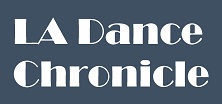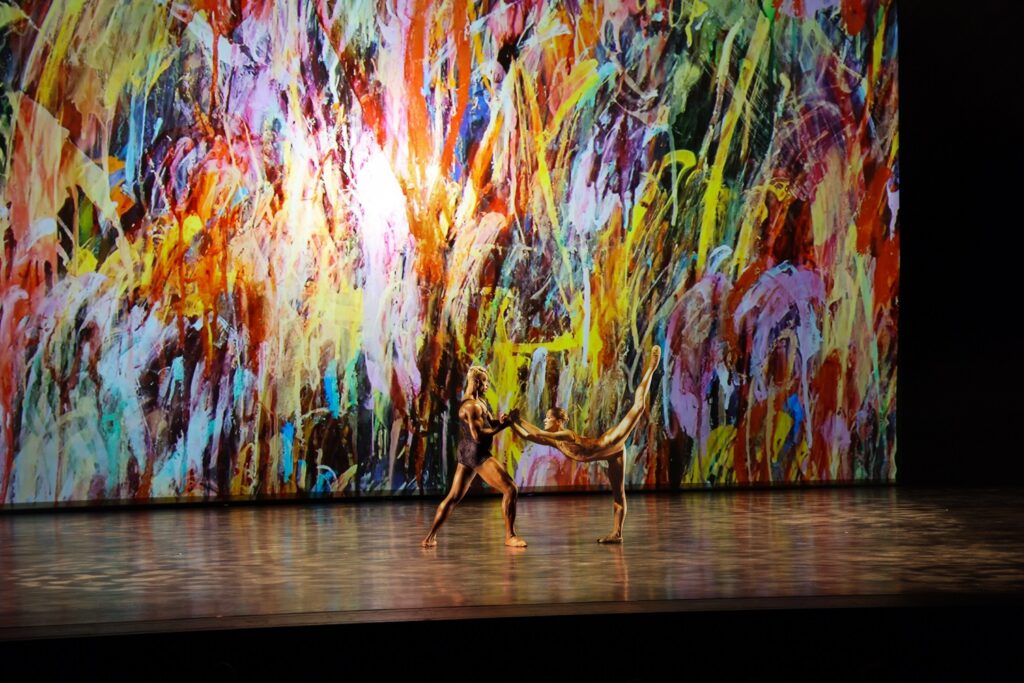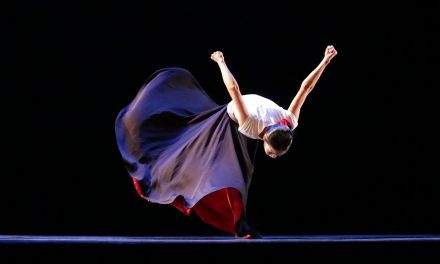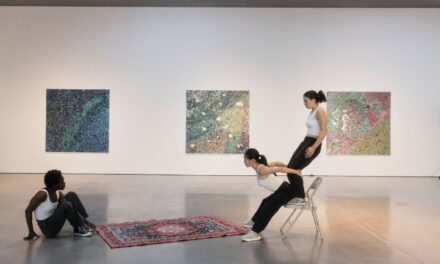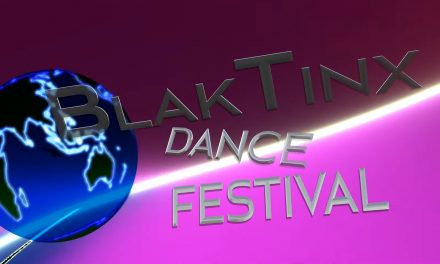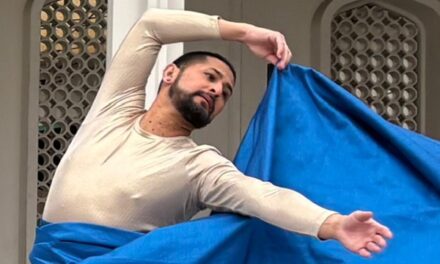There were three pieces on the Raiford Rogers Modern Ballet program at the Luckman Theatre which were acquired through a QR code. These were “Glassworks” (2024), World Premiere “Islands in the Sea” (2025), and World Premiere “Restless (encore)” (2025). All directed and choreographed by Raiford Rogers with the help of his assistant Lisa Gillespie. I will get back to the program later on.
It must be stated at the outset that Rogers’ dancers are extremely capable and adept at his style of choreography. They are clean and precise with laudable technique and stamina. They execute all movement beautifully and in concert when unison is called for. They were rehearsed to a razor’s edge which I appreciated a great deal. The exactitude of line is paramount in Rogers’ style and it was held by all. They were: Gustavo Barros, Marco Biella, Sadie Black, Bobby Briscoe, Joshua Brown, Laura Chachich, Sarah-Ashley Chicola, Cassidy Cocke, Poppy Coleman, Lillyan Fife, Lester González, Anna Jacobs, Hannah Keene, Julianne Kinasiewicz, Tetyana Martyanova Zyla, Jasmin Perry, Lucas Segovia, Jacob Soltero, Maté Szentes, and Paige Wilkey.
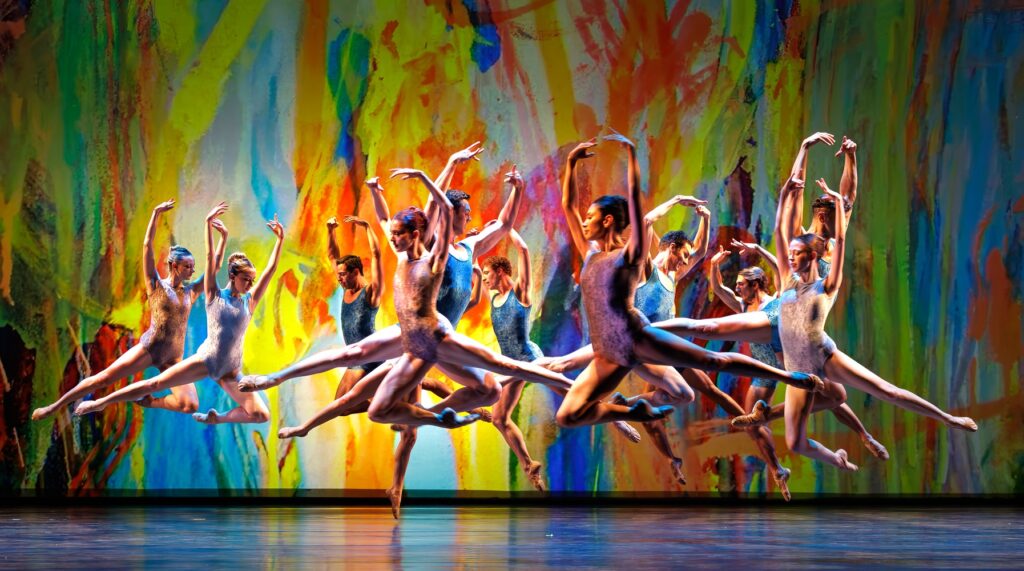
Raiford Rogers Modern Ballet in “Glassworks” choreography by Raiford Rogers – Photo by Steven Cohen.
The first piece was “Glassworks” with music by Philip Glass, Hui Yu on piano and organ, with projected painting progressions by Mike Nava. Nava’s paintings were fantastic and added a feeling of Art Gallery a’la Jean Cocteau. The lighting by John A. Garofalo was atmospheric and through a little smoke set off the dancers’ bodies brilliantly. Garofalo illuminated the skin tones of the bodies without glare or reflection. It was a chiaroscuro effect made powerful by just how much skin there was to be seen. The men wore short bike unitards in blue while the women wore silvery leotards and ballet shoes. The costumes were not credited in the program. In a way, I certainly understand not wanting costumes to get in the way of the choreography. The less one wears, the more one sees the anatomical mechanics of the human body executing movement. This aspect of the piece was made manifest in one female dancer who wore a white leotard and had an excruciatingly revealing solo adagio. I cannot tell her name nor how much I appreciated her performance as the program only listed the company of dancers en masse and not what parts they played or what solos they performed during the evening. More on that later. This woman’s body performing the solo was lit so that we saw every sinew, every tendon and joint flex and pull. Her face remained passive the entire time as if she were not a part of the intense exertion which her body was utilizing in order to accomplish its physical tasks. Her back, arms and legs grounded and then her muscles extended to move into a promenade in arabesque. Every torque and twist of her body was made obvious. I wonder why she wore anything at all if the point was seeing her muscles contort and exert. It was like watching a three-dimensional version of an anatomy chart. I do not think this was the intention behind the choreography, but it is what I saw. She would have made Herophilus proud. Whoever she is, she deserves kudos for that solo. Her focus and intent is phenomenal. She is obviously a very strong dancer with exacting ballet technique. I am sorry she was not credited for that solo in the program as I would like to sing her praises.
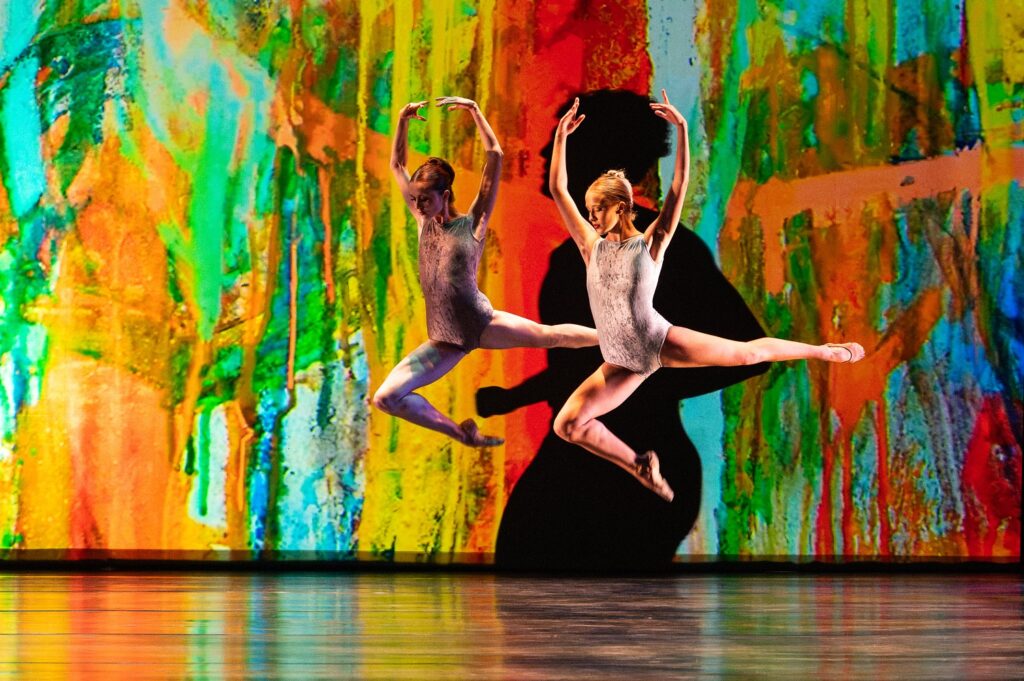 Rogers moves his dancers quite well in groups of three or six or two; all are integrated in this piece and the stage never suffers from being lax or dull. He makes great moving pictures on the stage with his dancers doing only three or four thematic phrases in multiple iterations, a theme and variations if you will. There were canons and unison and duets and solos. To say that the movement was repetitive is an understatement. I congratulate Rogers for making an entire piece with such limited vocabulary. It couldn’t have been easy and yet our eye never tired of the phrases or how they were manipulated. I believe a great deal of this is due to the caliber of dancers he had. They were killing themselves to smooth out transitions, plant their preparation for turns and jumps, and make some of the more idiosyncratic of Rogers’ choreography appear effortless. The paintings behind the dancers offset their movement and made a lovely canvas for the visuals in front. It was all very captivating and then… it ended. There was no finale, just the music section coming to an end and the dancers running offstage. The curtain came down and that is how I knew it was finished.
Rogers moves his dancers quite well in groups of three or six or two; all are integrated in this piece and the stage never suffers from being lax or dull. He makes great moving pictures on the stage with his dancers doing only three or four thematic phrases in multiple iterations, a theme and variations if you will. There were canons and unison and duets and solos. To say that the movement was repetitive is an understatement. I congratulate Rogers for making an entire piece with such limited vocabulary. It couldn’t have been easy and yet our eye never tired of the phrases or how they were manipulated. I believe a great deal of this is due to the caliber of dancers he had. They were killing themselves to smooth out transitions, plant their preparation for turns and jumps, and make some of the more idiosyncratic of Rogers’ choreography appear effortless. The paintings behind the dancers offset their movement and made a lovely canvas for the visuals in front. It was all very captivating and then… it ended. There was no finale, just the music section coming to an end and the dancers running offstage. The curtain came down and that is how I knew it was finished.
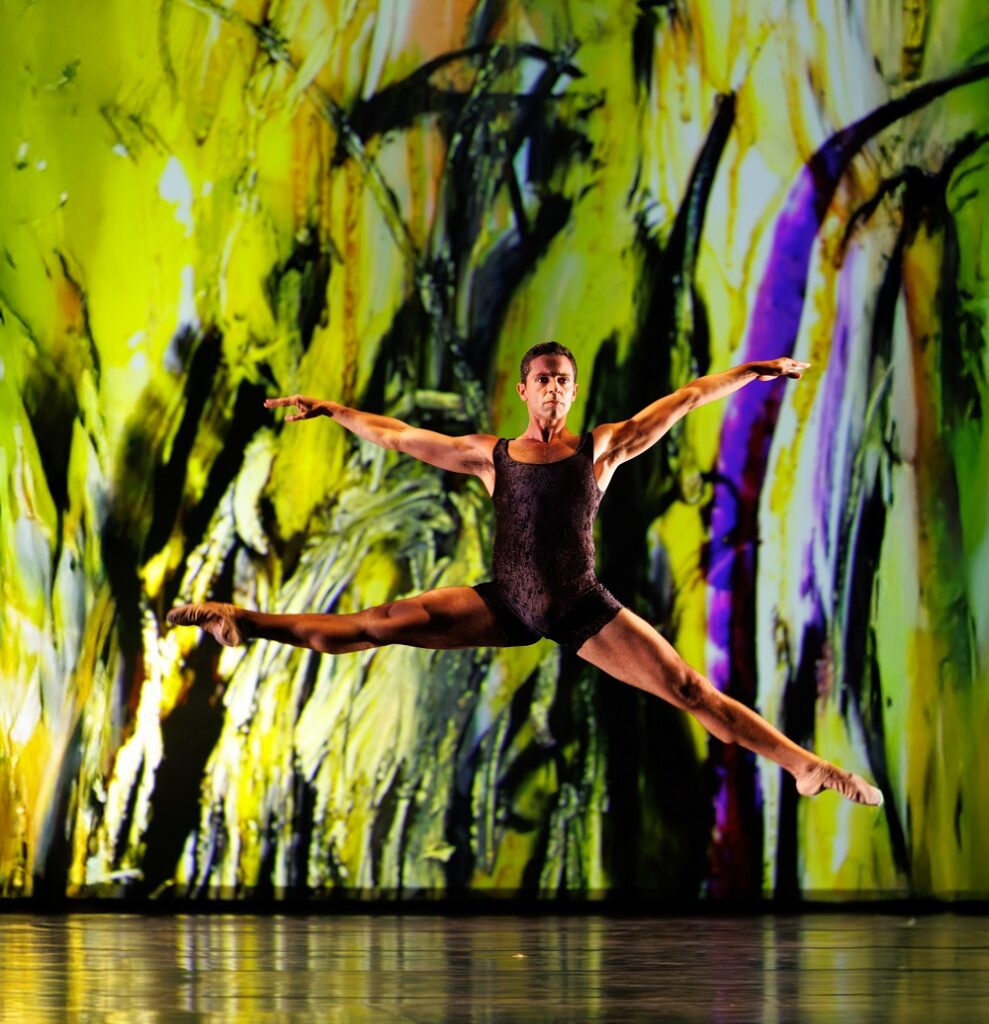
Raiford Rogers Modern Ballet – Lucas Segovia in Rogers’ “Island of the Sea” – Photo by Steven Cohen.
The second piece on the program was a ‘World Premiere’ called “Islands in the Sea” created in 2025. World Premieres are a big deal because it usually means that the choreographer is attempting something new and exciting. It may be a departure from their comfort zone in terms of story or set, music or theme. It may mean that the creator has a new avenue of inspiration and must follow it. Unfortunately, none of these were in effect in this piece. In fact, it was difficult to tell the difference between the first and second pieces on the program in terms of choreography, stylization, content and intent. Music by Arvo Pärt, Hui Yu on piano and organ, Stephanie Yu on piano, Elizabeth Wright on cello with projected painting progressions by Mike Nava and lighting by John A. Garofalo. Of course, it is no detriment to collaborate with the same artists and design team throughout ones’ career. However, the collaborations tend to be different showing different periods of taste and growth in the creator and also the team surrounding them. This is not the case with Rogers’ work.
One difference between the first and second ballets was that in the second piece the men wore short bike unitards in black while the women wore black leotards. There was another different solo female who wore a pink leotard. My advice here is that Raiford Rogers Modern Ballet should never present these two works on the same program again. They are, for all practical purposes, the same. I was a little confused in that after “Islands in the Sea” the two female soloists took a bow, but no one else did. Then as I was waiting for the rest of the company to bow, the “Restless encore” began. And the company exploded onto the stage wearing…. what else, but red short bike unitards for the men and red leotards for the women. There were the same choreographic phrases but this time there were smiles and palpable fun being expressed by the company. Whether they were told to be happy and enjoy the movement or not I do not know. It was a welcome respite from the intense focus that went before.
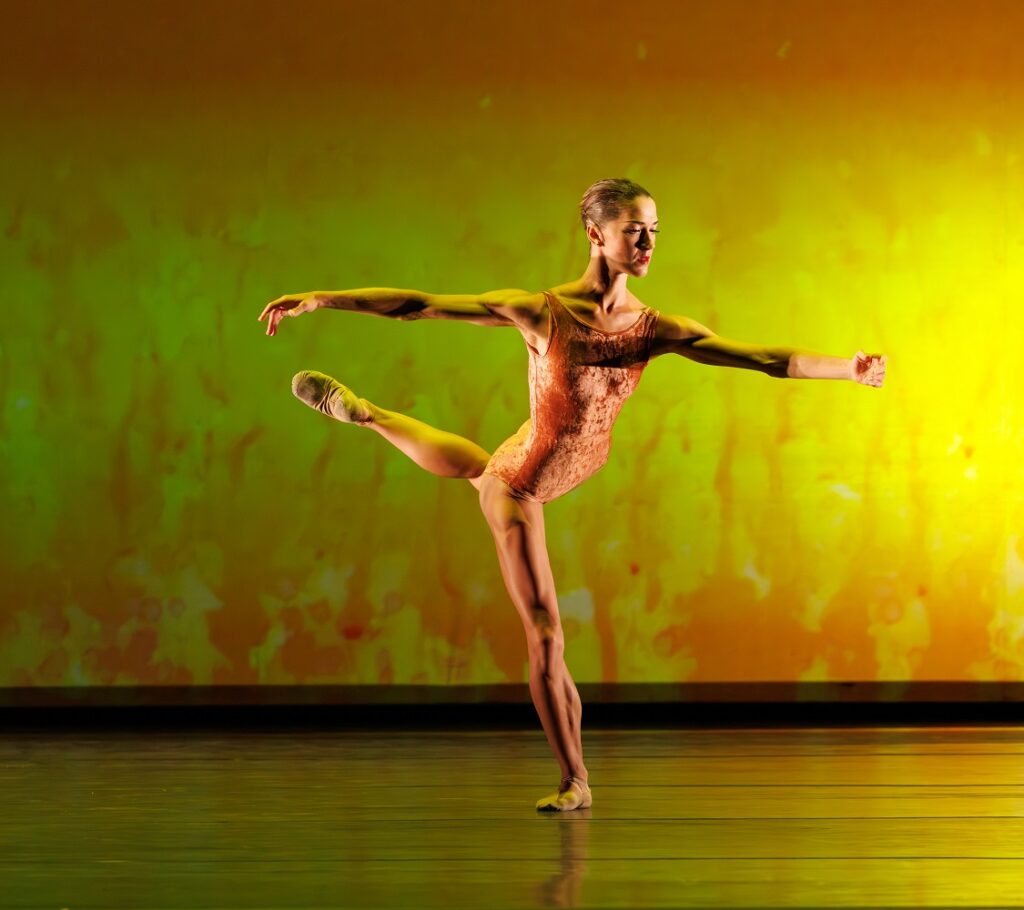
Raiford Rogers Modern Ballet – Tetyana Martyanova Zyla in Rogers’ “Islands of the Sea” – Photo by Steven Cohen.
In closing I would like to bring attention to what I feel is an egregious omission of credit in the program. I understand that a ballet ensemble performing in every piece may be simply listed in the program. But when there are sections in the work that comprise lengthy solos, it is customary to credit the individual dancers in the program. Interestingly, the musicians were singled out and named for their part and their instrument. I only wish the same were true of the two female soloists in each of the two works on the program. They were seen and appreciated and noticed and cheered by me and the rest of the audience. I just don’t know who they are and that is a shame.
For more information about the Raiford Rogers Modern Ballet, please visit their website.
To learn more about the Luckman Fine Arts Complex, please visit their website.
Written by Brian Fretté for LA Dance Chronicle.
Featured image: Raiford Rogers Modern Ballet in Rogers’ “Islands of the Sea” – Photo by Steven Cohen.
